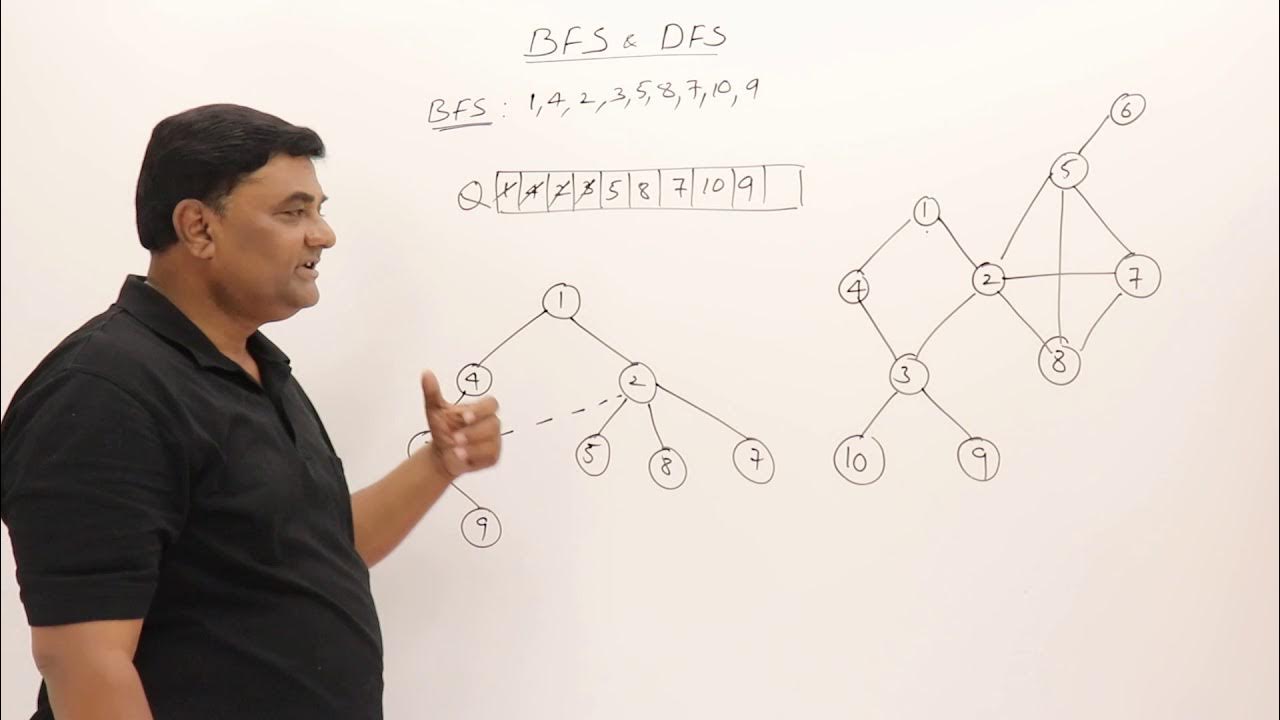Breadth First Search BFS
Summary
TLDRIn this video, the presenter compares two fundamental search algorithms: Breadth-First Search (BFS) and Depth-First Search (DFS). BFS explores nodes level by level, ensuring the discovery of the optimal solution but at the cost of higher memory usage and slower performance. DFS, on the other hand, delves deep into paths before backtracking, often finding solutions faster but risking inefficient paths. The video also includes practical coding examples of BFS and DFS, discussing their application in solving problems like finding the shortest path in a graph. The presenter emphasizes when to use each algorithm for optimal results.
Takeaways
- 😀 BFS (Breadth-First Search) explores nodes level by level, visiting all nodes at the current level before moving to the next level.
- 😀 DFS (Depth-First Search) explores nodes by going deep into one branch before backtracking to explore other branches.
- 😀 One key advantage of BFS is that it avoids dead ends and can find the optimal solution when multiple solutions exist.
- 😀 BFS requires more memory compared to DFS as it needs to store all nodes at a particular level in memory.
- 😀 BFS may take longer than DFS if the solution is located deeper in the search tree, as it must explore each level before reaching the next.
- 😀 DFS may be more efficient in cases where the solution is found early in a deep branch, as it prioritizes depth over breadth.
- 😀 Both BFS and DFS have their own pros and cons: BFS is better for finding the shortest path, while DFS may be quicker in some cases.
- 😀 The BFS algorithm can be simulated by placing nodes into a queue and exploring them one by one, ensuring level-wise exploration.
- 😀 If BFS doesn't find a solution at one level, it continues searching deeper levels until a solution is found or all options are exhausted.
- 😀 In contrast, DFS starts with the first branch and explores deeper until it either finds the solution or backtracks if it reaches a dead end.
- 😀 The tutorial also compares BFS and DFS using an example of a shortest path search, demonstrating how each method approaches the task differently.
Q & A
What is the primary difference between BFS and DFS in terms of traversal strategy?
-BFS (Breadth-First Search) explores nodes level by level, starting from the root node and moving outward horizontally. DFS (Depth-First Search), on the other hand, explores as deeply as possible along one branch before backtracking and exploring other branches.
What is a key advantage of BFS over DFS?
-A key advantage of BFS is that it guarantees finding the shortest path in an unweighted graph, since it explores all nodes at a given depth before moving to the next level.
What is one major disadvantage of BFS?
-One major disadvantage of BFS is that it requires a significant amount of memory because it stores all the nodes at each level in a queue.
What is one advantage of DFS over BFS?
-DFS typically requires less memory compared to BFS because it explores deeper into the tree or graph before backtracking, only storing nodes along the current path.
Why is BFS considered more efficient in certain situations like finding the shortest path?
-BFS is more efficient for finding the shortest path because it explores nodes level by level, ensuring that the first time a solution is found, it is the shortest one.
How does BFS handle memory usage differently from DFS?
-BFS uses more memory than DFS because it needs to store all the nodes at the current level in a queue, whereas DFS only stores the nodes along the current path in a stack.
What happens if BFS encounters multiple solutions in a search?
-If BFS encounters multiple solutions, it will find the solution at the minimum depth, ensuring that the first solution it encounters is the optimal one.
In what types of problems is DFS generally preferred over BFS?
-DFS is preferred in problems where finding the solution deeper in the search tree is more important or when memory usage is a constraint, such as in large search spaces with many nodes.
Can DFS be guaranteed to find the shortest path in an unweighted graph?
-No, DFS cannot guarantee the shortest path in an unweighted graph because it does not explore nodes level by level, and it may find a solution that is not the shortest one.
How does the search process differ when using BFS compared to DFS in a practical scenario?
-In BFS, the algorithm starts at the root and explores all nodes at the current level before moving to the next, ensuring a level-wise search. In DFS, the algorithm dives as deep as possible along one branch before backtracking and exploring other branches.
Outlines

このセクションは有料ユーザー限定です。 アクセスするには、アップグレードをお願いします。
今すぐアップグレードMindmap

このセクションは有料ユーザー限定です。 アクセスするには、アップグレードをお願いします。
今すぐアップグレードKeywords

このセクションは有料ユーザー限定です。 アクセスするには、アップグレードをお願いします。
今すぐアップグレードHighlights

このセクションは有料ユーザー限定です。 アクセスするには、アップグレードをお願いします。
今すぐアップグレードTranscripts

このセクションは有料ユーザー限定です。 アクセスするには、アップグレードをお願いします。
今すぐアップグレード関連動画をさらに表示

AI - Ch03 - Uninformed search algorithms

Projeto e Análise de Algoritmos - Aula 12 - Algoritmos de busca em largura e profundidade em grafos

Algoritma Greedy Best First Search dan A* (A star) + Contoh dan Penjelasan | Algoritma Struktur Data

5.1 Graph Traversals - BFS & DFS -Breadth First Search and Depth First Search

Depth First Search (DFS) Graph Traversal in Data Structures

The Best Order to learn Algorithms & Data Structures?
5.0 / 5 (0 votes)
